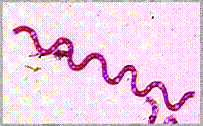


 email: babcocgf@ucbeh.san.uc.edu
email: babcocgf@ucbeh.san.uc.edu
The LIVE/DEAD BacLight Viability Kit (Molecular Probes, Inc.) enables distinction of live and dead bacteria even in mixed populations containing a variety of bacterial types. The kit incorporates two proprietary nucleic acid stains which differ in their ability to penetrate bacterial cell membranes. Bacteria with intact membranes
allow only one dye to enter the cell and fluoresce green, whereas those with damaged membranes allow both
dyes to enter and fluoresce red or red/green. The heterogeneous staining pattern produced by the BacLight
kit has not been fully defined as to which populations represent viable and which represent non-viable
organisms. This matter is further complicated when testing antibiotics which can be bacteriostatic or
bactericidal.
In this study, we examined the viability of various populations of bacteria as defined by the
staining patterns produced by the BacLight kit following treatment with disinfectants, heat, or
antibiotics. Bacterial populations (histogram regions) were defined by the staining pattern observed by flow cytometric analysis. Viability was determined by sorting and plating on media or autocloning directly into broth. Each region was arbitrarily numbered (1-5) and characterized as viable, non-viable, or mixed.

 Back to Flow Cytometry and Microbiology Introductory Page
Back to Flow Cytometry and Microbiology Introductory Page
